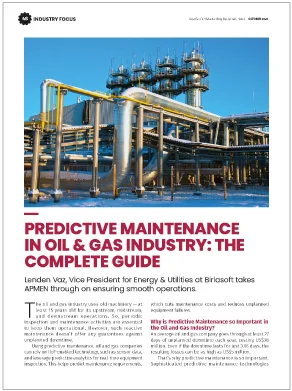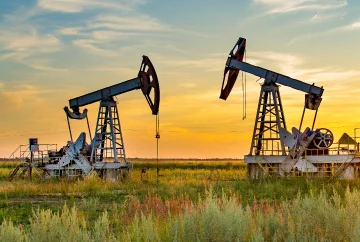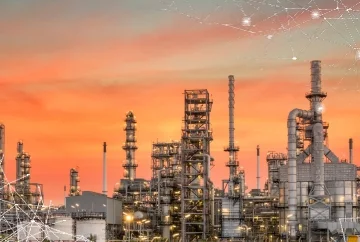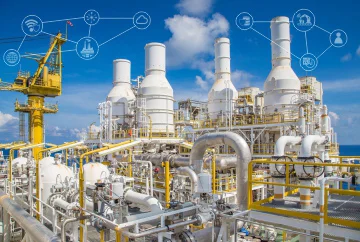#7 IoT Pipeline Monitoring
Crude oil and natural gas pipelines span long distances, bringing them under the scrutiny of numerous regulations to ensure operational efficiency and personnel safety. Flaws in these pipelines can lead to accidents such as explosions or leakages and cause significant environmental damage.
That’s where real-time
pipeline monitoring can help. With continuous monitoring and tracking of essential KPIs, oil and gas companies can immediately respond to potential issues and fix them as they occur, which reduces the likelihood of unplanned shutdowns and subsequent revenue losses.
#8 Drill Corrosion Detection and Maintenance
The global cost of corrosion is
$2.5 trillion, and corrosion control techniques can save oil and gas companies anywhere between $375-875 billion annually. Corrosion occurs when metal is exposed to electrochemical during drilling operations. While corrosion inhibiting alloys in equipment help mitigate the damage, it isn’t foolproof because of the challenges presented by the oil wells.
That’s why equipping drilling equipment with
corrosion detection sensors can facilitate early detection and repairs.
Benefits of Predictive Maintenance for Oil Companies
Predictive maintenance systems can help oil and gas companies turbocharge their performance, optimize costs, and grow revenues. For instance, oil and gas giant
Repsol is using predictive maintenance to improve equipment health and productivity. As a result, the company has reduced unplanned maintenance by 15%, leading to $200 million in annual savings in its operational expenses. So, let’s look at some of the most significant benefits.
Click to zoom in
Higher Cost Savings
US refineries lose
$6.6 billion because of unplanned downtime and poor equipment maintenance. Additionally, unwarranted yet routine inspections, which are standard in reactive maintenance, are also costly.
That’s where predictive maintenance can provide significant cost savings since it operates on the premise that maintenance should only be performed when the performance has decreased or there’s a chance of impending equipment failure.
Improved Operational Efficiency
Predictive maintenance systems make maintenance more efficient, as technicians can use a single, centralized dashboard to track and monitor all the performance of all assets in real-time, regardless of the location. This boosts the overall operational efficiency of oil and gas operations.
Reduction in Unplanned Downtime
As mentioned earlier, even four days of unplanned downtime can cost millions. However, using predictive maintenance, oil and gas companies can develop machine learning algorithms that, for instance, predict failures in gas compressor trains with over
70% accuracy, making these systems more reliable and less prone to unplanned downtime.
Workplace Safety
During
extraction processes, workers can be affected by toxic emissions. Additionally, since several oil and gas operations occur in remote locations, sudden equipment breakdown can jeopardize employee health and safety.
Oil and gas companies can reduce the risks of such hazards and conduct safer operations using predictive maintenance. Moreover, they can tap into predictive analytics to identify potential natural gas sources with greater accuracy.
Environmental Regulatory Compliance
The
oil and gas industry faces increasing regulatory pressure to reduce emissions, leakages, and other environmental hazards. For instance, the US oil and gas companies release 1 million tons of methane gas into the environment. IIoT-powered technologies can help companies spot and intervene before another pipeline leak occurs. They can also map energy usage patterns to identify ways of making the operations more energy efficient.
How to Build Your Predictive Maintenance Strategy
Accurate
predictions and forecasting warrant high-quality, useful, and actionable data. That’s why the success of any predictive maintenance strategy relies on an organization’s master data management and governance frameworks. At the same time, oil and gas companies must establish a robust analytics infrastructure capable of processing and storing large volumes of big data.
The next step is to get buy-in from the senior leadership by demonstrating the value of
predictive maintenance and decision-making driven by analytics. That’s where tying the outcomes of predictive maintenance initiatives with the overall strategic initiatives comes in handy.
This should be followed by substantial investments in hiring the right experts — data scientists and analysts — and the relevant predictive maintenance technologies to build analytics models that generate real value.
The Future of Oil & Gas Industry
Predictive maintenance has the potential to generate substantial cost savings for the oil and gas industry. For example, IoT solutions can increase production by 25%. Additionally, they can reduce maintenance costs by 30% and equipment downtime by 45%. That’s why oil and gas giants such as Shell, ExxonMobil, BP, Chevron are already tapping into technologies powered by
AI and IoT, such as predictive maintenance, to cut costs and boost efficiency. However, while predictive maintenance looks promising for the oil and gas industry, it’s just one aspect on the path to
complete digital transformation in the oil and gas world.








